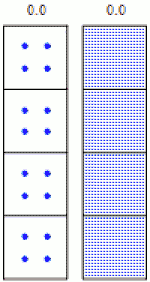Nuclear decay

Nuclear decay
N(t) = e-ln(2) t / t½
In the Figure, this is shown for four groups, each with 4 (left) or 400 (right) nuclei. In the counter at the top, the time runs from 0 to 4 half-lives. At the end of the simulation period, there is an average of about 1/16 of the initial number of nuclei left.
The most common decay modes are:
- α-decay: the nucleus emits a helium nucleus
- β-decay: the nucleus emits a positively or negatively charged electron, or the nucleus captures an orbital electron
- γ-decay or internal conversion: the nucleus emits a γ-photon, or the decay energy is transferred to an orbital electron
- nuclear fission: the nucleus breaks asymmetrically into two parts with a mass ratio of about 2:3